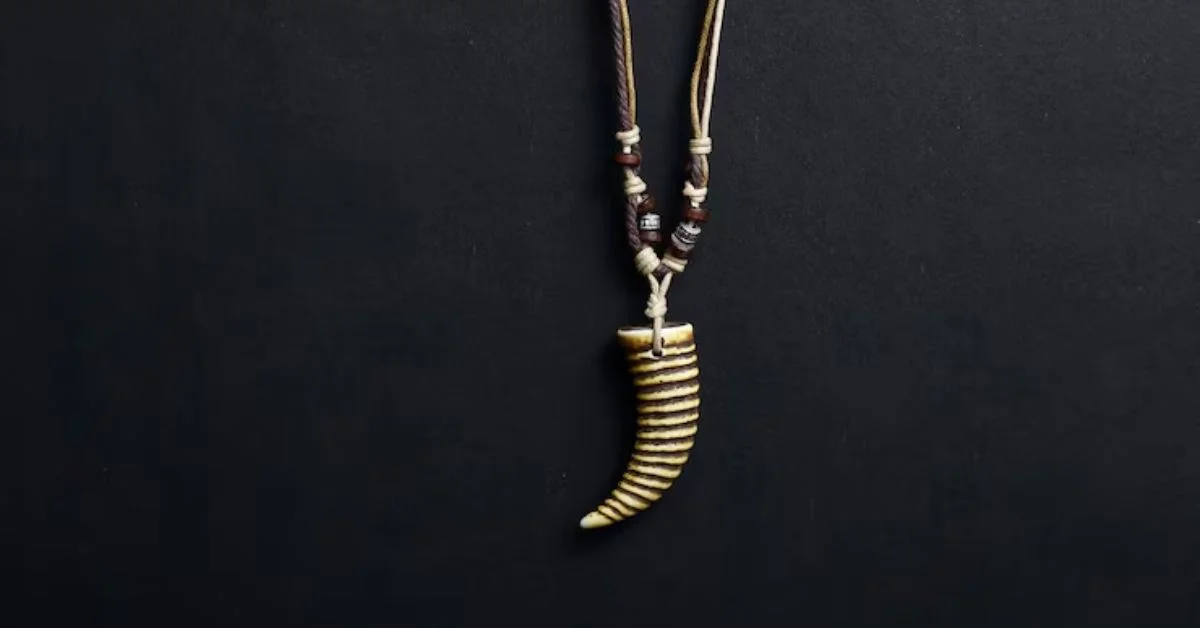At first glance, it may seem like a simple piece of jewelry—a fossilized tooth suspended on a leather cord or sterling chain. But beneath its polished surface lies a rich convergence of prehistoric biology, cultural identity, environmental awareness, and commercial appeal.
A megalodon tooth necklace is more than a wearable relic. It’s a tangible piece of ancient Earth, a bold fashion statement, and often a personal totem representing strength, resilience, and curiosity. As interest in ancient history, marine biology, and natural materials grows, so too does the popularity of this item—worn equally by fossil hunters, surfers, museum enthusiasts, and everyday wearers intrigued by its raw, primeval power.
This article dives deep into the cultural, scientific, and symbolic dimensions of the megalodon tooth necklace—exploring what makes it more than just an accessory, and why it continues to intrigue people across generations and continents.
The Megalodon: Nature’s Original Apex Predator
To understand the appeal of the megalodon tooth necklace, one must first understand the creature from which it originates. The Megalodon (Otodus megalodon) was an enormous prehistoric shark that ruled Earth’s oceans approximately 23 to 3.6 million years ago, during the early Miocene to Pliocene epochs.
Estimated to grow up to 60 feet in length, the megalodon had a bite force unmatched by any known marine predator—past or present. Its teeth, often measuring 3 to over 7 inches in height, were serrated and shaped for slicing through the flesh and bone of whales and large fish. These formidable tools are what remain of the creature, fossilized and sometimes uncovered in pristine condition millions of years later.
Fossilized teeth from the megalodon are the most accessible way for humans to connect with this ancient titan. And when turned into jewelry—particularly necklaces—they carry more than just historical intrigue: they symbolize a direct link to Earth’s distant past.
What Makes a Megalodon Tooth Necklace?
A megalodon tooth necklace is exactly what the name implies: a fossilized tooth from the prehistoric shark, cleaned and often polished, mounted onto a string or chain and worn as a pendant. But the variety, quality, and craftsmanship of these necklaces vary widely.
Key Features: Megalodon Tooth Necklace
- Authentic Tooth: True megalodon teeth are fossilized remains, often found in riverbeds, quarries, or coastal dig sites.
- Polished or Raw Finish: Some prefer a high-gloss polish, while others seek an unrefined, natural look.
- Setting Material: The tooth can be wrapped in wire, placed in a silver or gold bezel, or drilled directly to be worn on leather, hemp, or metal chains.
- Size: Tooth pendants can range from small, inch-long pieces to massive 6-inch statements.
- Accompanying Symbols: Some necklaces include tribal carvings, ocean motifs, or gemstones to add spiritual or stylistic layers.
Each necklace tells a story—not only of geological time, but also of the human who wears it.
Symbolism and Personal Meaning
For many wearers, the megalodon tooth necklace isn’t just a fashion statement—it’s a symbolic talisman. Here’s how it’s often interpreted:
1. Strength and Power
The megalodon was an apex predator, feared and unchallenged. Wearing its tooth can be a personal reminder of one’s inner strength, survival, or dominance over challenges.
2. Connection to Nature
The necklace offers a tactile link to Earth’s ancient past and the raw forces of the ocean, reinforcing environmental awareness or personal grounding.
3. Mystery and Depth
The oceans still hold secrets. For those drawn to the mysterious, the tooth serves as a reminder of unexplored realms—both external and internal.
4. Transformation
A tooth once used for destruction becomes a wearable relic. This transformation can represent healing, redemption, or personal evolution.
These symbolic interpretations make the necklace an especially popular gift item for milestones—graduations, career changes, or life recoveries.
Science and Authenticity: Are All Megalodon Teeth Real?
As demand has grown, so too has the market for fake or imitation megalodon teeth. Authenticity is critical—not only for value but for ethical and scientific reasons.
How to Spot a Real Megalodon Tooth:
- Fossilization Signs: Real teeth show mineralization, often in muted colors like gray, tan, or black.
- Weight and Density: Authentic teeth feel dense due to fossilization.
- Striation and Serration: Real teeth display visible growth lines and jagged edges (if intact).
- Location Disclosure: Sellers should list where the fossil was found—common sources include Florida, South Carolina, and Morocco.
Some teeth sold online are either replicas or composite casts. While these may serve as stylish accessories, they lack the genuine prehistoric origin that many buyers seek.
Ethical Sourcing and Legal Considerations
With growing environmental awareness, more buyers are asking: Where did this fossil come from, and was it ethically collected?
Ethical Sourcing:
- Private Land Excavation: Collecting from private land with the owner’s permission is generally legal and ethical.
- Regulated Digs: Some commercial sites operate under scientific observation or licensing.
- Illegal Harvesting: Teeth extracted from protected areas or stolen from heritage sites are illegal and compromise conservation efforts.
Buyers should ask for documentation or sourcing claims, especially when paying premium prices. Ethical fossils not only support responsible digging but protect the integrity of paleontology.
The Fashion Perspective: A Rising Trend
The megalodon tooth necklace has moved from niche souvenir shops into mainstream fashion conversations. Surf brands, outdoor lifestyle companies, and even high-end designers have started integrating fossil motifs into accessories.
Why It Works in Fashion:
- Natural Material Appeal: As sustainability becomes fashionable, natural and ancient materials gain prestige.
- Gender-Neutral Aesthetic: Tooth necklaces appeal across gender lines—rugged yet minimalistic.
- Conversation Starter: A megalodon tooth hanging around one’s neck immediately invites questions and stories.
- Celebrity Boost: From actors to athletes, high-profile figures have been spotted wearing shark tooth necklaces, driving cultural interest.
Whether paired with a linen shirt on a beach vacation or a leather jacket at a concert, the necklace adapts to varied styles while retaining its primal edge.
Value and Market Trends
A megalodon tooth necklace can cost anywhere from $30 to over $3,000, depending on the tooth’s size, condition, rarity, and how it’s mounted. Key factors influencing price include:
- Tooth Size and Quality
- Polish and Finish
- Age and Provenance
- Setting Material (Silver, Gold, etc.)
- Brand or Artisan Reputation
Premium necklaces, especially those incorporating 5- to 6-inch teeth with custom metalwork, are often sold as collectibles, not just jewelry. The market is growing, with collectors, designers, and paleontology enthusiasts converging in the same space.
Megalodon Teeth in Education and Public Museums
Beyond fashion, megalodon teeth serve as crucial teaching tools in schools and science centers. Some institutions have even started incorporating wearable replicas in educational kits to engage students.
They help illustrate: Megalodon Tooth Necklace
- Geological time scales
- Evolution of marine life
- Climate changes from the Miocene epoch
- Predator-prey dynamics
This dual-purpose value—educational and aesthetic—makes the megalodon tooth necklace a versatile artifact in modern life.
Care and Preservation
Because fossilized teeth are ancient, they require mindful handling, especially when worn.
Tips for Preservation:
- Avoid Excess Moisture: Although fossilized, exposure to saltwater or chlorine can degrade the material.
- Polish with a Soft Cloth: To maintain sheen without damaging mineral surface.
- Store Separately: Avoid metal-on-metal contact that could chip the enamel or root.
- Inspect Regularly: Check necklace settings or cords to avoid accidental loss.
Environmental Messaging: From Predator to Protector
Some wearers use their necklace as a statement piece for ocean conservation. With shark populations under threat from commercial fishing and finning, the necklace becomes not a trophy of conquest, but a reminder to protect Earth’s remaining giants.
Organizations now sell ethically sourced megalodon tooth necklaces as part of fundraising efforts for:
- Coral reef restoration
- Anti-poaching campaigns
- Marine biodiversity education
This shift reframes the necklace from a symbol of dominance to one of stewardship—a powerful narrative in a warming world.
Conclusion: Wearing the Past to Shape the Future
A megalodon tooth necklace is not merely a relic, a fashion item, or a status symbol. It is a multidimensional object that fuses deep time with modern identity, reminding us of where we come from and challenging us to consider how we engage with history, nature, and fashion.
To wear such a piece is to shoulder part of Earth’s evolutionary legacy. Whether worn for power, protection, or passion, it speaks to a shared curiosity about what came before—and what lessons those ancient forms still offer us today.
FAQs
1. Are all megalodon tooth necklaces made from real fossils?
No. Some are replicas or casts made from resin or composite materials. Always verify authenticity if you seek a genuine fossil.
2. How old is a real megalodon tooth?
Authentic megalodon teeth date between 3.6 to 23 million years old, depending on their excavation site.
3. Is it legal to buy and wear a megalodon tooth?
In most cases, yes—provided the tooth was ethically sourced and not collected from protected areas or stolen from museums.
4. Can I wear my megalodon tooth necklace in water?
It’s best to avoid prolonged exposure to saltwater or chlorinated pools, which may degrade or stain fossilized material over time.
5. What should I look for when buying a megalodon tooth necklace?
Look for size, condition, origin, setting quality, and authenticity. Ethical sourcing and seller transparency are also key.
For more information, click here.









